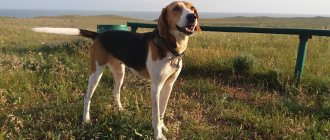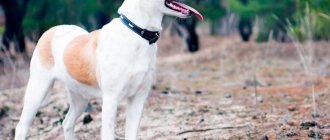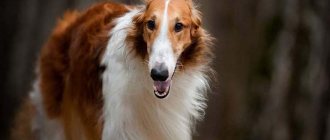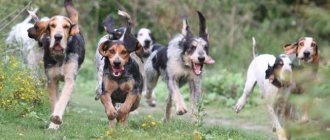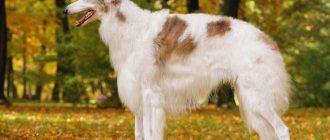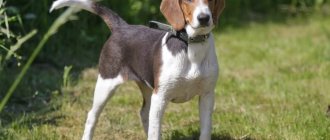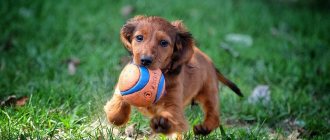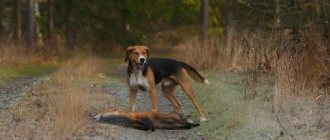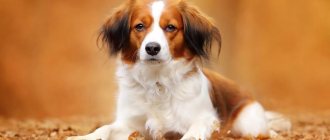a brief description of
- Other names: Russian Piebald Hound, Gontchaja russkaja pegaja, Russian harlequin hound, English-Russian Hound, English-Russian hound, Russian piebald.
- Height: up to 68 cm.
- Weight: up to 30 kg.
- Color: body black and piebald with tan, perhaps gray-piebald or crimson-piebald with slight speckling, limbs and belly are white.
- Coat: short on the head, 5-6 cm along the body, soft, short, dense undercoat.
- Life expectancy: up to 13 years.
- Advantages of the breed: Brave hunter and devoted friend. The dog is a passionate, dexterous, agile dog for energetic and active people who prefer hunting red animals.
- Difficulties : The dog is prone to escape due to its hunting instinct.
- Price: up to $500.
Origin story
Russian Piebald as a breed appeared in the Russian Empire during the reign of Elizabeth. Hunting was considered the favorite pastime of noble people during the heyday. English hounds, previously imported as gifts, began to be crossed with the Russian variety of hunting dogs. The piebald hound is still mistakenly called the Russian hound, although the dogs have quite a lot of differences.
Until 1951, the dogs were called Anglo-Russian the Russian Hound , recognized by the World Cynological Association FCI, and the Russian Piebald , outside the FCI classification, began to exist Almost all representatives of the breed live on the territory of the Russian Federation, and only a small proportion of dogs are kept in the neighboring countries of Eastern Europe.
Purpose of the breed
Despite the lack of recognition by the FCI, the dogs are very popular, especially among those who like pack hunting . The price for the Russian Piebald Hound breed has been relatively stable over the past 10-15 years, and demand is steadily growing. In addition to hunters, dogs are preferred by people leading an active lifestyle.
The piebald hound is a wonderful companion if enough time has been devoted to its upbringing. But if mistakes were made in the process of introducing the dog to the domestic way of life, the animal will exist, obeying instincts - to follow the trail of the intended prey, to start hunting when it pleases. Therefore, the largest percentage of lost animals are Russian piebalds .
Performance evaluation and information
According to the standard description of the breed, the Russian piebald hound is a strong dog with well-developed muscles, a massive skeleton and a harmonious proportional build. Its height is:
- for a male - 58-68 cm;
- in a female - 55-65 cm.
The weight of the animal is not specified by standards.
The color is, in most cases, white with black and red spots on the head, shoulders and back of the animal. In addition, red-piebald, gray-piebald and light speckled colors are considered standard. At the same time, black spots can be of very different sizes, and on the temples there are small marks in the form of arrows.
Character
Dogs have an extraordinary temperament against the backdrop of pronounced hunting qualities . By nature, the piebald hound is a rather obstinate creature . The animal accompanies its dissatisfaction with a heart-rending bark, and may even growl.
It should be noted that the voice of the Russian Pinto Hound was initially noted as the main characteristic of the breed and was considered quite musical. By barking, a dog expresses its state - from desires to grievances. This quality is indispensable when hunting, but in everyday life it can become a serious irritant. Fortunately, well-mannered pets prefer to behave with restraint at home.
Dogs become attached to their owner and even help in raising children , playing outdoor games with them and protecting them from uninvited guests. As for other pets, here the Russian hound can show all its temper, even to the point of aggression, even if it grew up with pets, as they say, from the cradle.
Character of a hunting dog
The Russian hound is good-natured, peaceful and friendly. She is very energetic, active, is a true friend to her owner and gets along well with children. Hunting with a Russian piebald hound turns into a real pleasure, since this dog is tireless, enthusiastic, has an excellent sense of smell and is perfectly trained, although it requires a certain firmness.
The animal is able to pursue its prey for a long time and patiently, and its sonorous voice will notify the owner of the victorious ending of this chase. The Russian Piebald gets along well with animals living in the same house, so it can easily be kept in a family.
Choosing a puppy
Purchasing a piebald hound puppy is practically no different from purchasing a baby of any other hunting breed. Due to the ingenuity of the Russian soul, it is recommended to take a dog to a kennel , where you can verify the breed of the puppy.
In dogs of the Russian Piebald Hound breed, puppies are born white with slight black spots , and only over time the contrast intensifies and blush appears.
Puppies, as a rule, already at one month of age are noisy, talkative, active , and can be taken to a new home. At the age of one month, it is easier to teach a puppy to go to the toilet in a diaper while the quarantine period is in effect after the first necessary vaccination.
When purchasing a puppy, you should pay attention to its activity . If he is silent and avoids his brothers, something is wrong in the baby’s health. He urgently needs to take his temperature and contact a veterinarian. Abdominal bloating at this age may indicate rickets, or may be a consequence of the presence of worms in the gastrointestinal tract.
Hunters prefer to take older puppies, no younger than 6 months, but no older than 8 months . The teenager’s body has practically formed, and all the negative factors of heredity, if they exist, have appeared.
In any case, you should conclude a purchase and sale agreement with the breeder and receive the necessary recommendations for raising a Russian pinto - conditions of keeping, feeding, training independently or with the invitation of an experienced dog handler.
How to choose a puppy and its price
Since the Russian Piebald Hound is a fairly common breed, the price of its puppies is very affordable and starts at $50 for a dog without a pedigree. And the maximum price is about $500 for an animal with an excellent pedigree. When choosing a puppy, you need to pay attention to its healthy appearance and active behavior. Immediately discard puppies with a bulldog jaw, as this indicates degeneration. Also pay attention to the color of the eyes; the presence of a green tint indicates a discrepancy with the breed. In addition, there should be no pink areas on the nose; this defect is called marbling of the nose.
When choosing a dog, many look at “hunters” - it is believed that they are more attached to people. And it's true: such animals work well in a team. But sometimes it’s not easy to decide on the selection; we advise you to learn more about representatives of hunting dog breeds in five parts: , , , , .
If possible, you should evaluate the behavior of puppies during feeding; the most persistent of them will eventually develop into strong and persistent adults.
Nicknames and names
These not quite ordinary dogs have names that fully correspond to them. Names, as a document of identity, reflect the character and habits of dogs. Nicknames are given to be capacious, sonorous , so that the dog can hear it among the many other sounds heard, especially when hunting:
- for males - Bass, Thunder, Clarinet, Orpheus, Bassoon, Zvonok, Typhoon, Hurricane;
- bitches - Boyka, Galka, Dudka, Lute, Norma, Song, Strelka, Flute, Laughter.
Care and maintenance
The breed is completely easy to maintain . Dogs are a priori not intended to be kept in an apartment . Even in a private home, it is preferable to keep animals in a spacious enclosure , closing them only during periods of bad weather.
Caring for a dog is completely simple . Dogs are brushed once a week, but during the shedding period the procedure is increased, brushing the pet every other day. The dog wears its claws down on walks itself. The dental system is naturally strong; only with age, some representatives of the breed may develop plaque that needs to be cleaned in a veterinary clinic.
Eyes and paw pads are examined daily. It is necessary to clean your pet's ears regularly and preferably every day.
But bathing a Russian pinto is often not recommended. In the summer, the dog itself swims beautifully in open water, and in the winter it knows how to clean itself with snow.
Diseases and care
The breed is distinguished by its strong endurance and excellent health. At the same time, the puppy’s health must be treated with the utmost care, since hereditary diseases can shorten the dog’s life. The first disease can lead to degenerative destruction of the joints, the next one can lead to significant damage to the spinal cord caused by deformation of the vertebrae.
If we start talking about acquired diseases, here Russian hounds should be wary of:
- conjunctivitis (inflammatory processes of the eyes);
- malignant hypertension, which affects representatives of the breed with enviable consistency;
- myositis, which is inflammation of muscle tissue.
The Russian Piebald Hound does not require any special care. The only conditions are a balanced diet and proper physical development. Please note that if you do not have the opportunity to walk with your pet for at least three hours a day, then it is better to refuse to adopt a Russian pinto hound.
You should bathe your dog as needed. Definitely after the hunt. Coat care is also incredibly simple - cleaning and combing occurs during the molting period. The tendency of various types of conjunctivitis requires daily eye examination. There are usually no problems with the health of the ears and teeth, but this should in no way exempt your dog from medical examinations.
Health and heredity
As a typical representative of hunting dog breeds, the Russian Piebald is prone to allergies of various etiologies . Basically, allergic reactions occur against the background of improper and irrational nutrition. A poorly balanced diet can cause the development of hip dysplasia.
Well, in general, the breed is quite resistant to various diseases with the exception of infectious diseases transmitted by blood-sucking parasites. Therefore, seasonal treatments against mosquitoes, ticks and fleas are very important for the health of your pet.
Which owner is it suitable for?
It is very important for the owner of this breed to show character and not follow the animal’s lead, especially during the initial training. Like most pack animals, the Russian hound respects and listens to the “leader”; if you give in to him at least once, it will be very difficult to put the dog in his place. Therefore, it is better to have this breed for strong and determined people. In addition, like any hunting dog, the Russian piebald hound needs long and active walks, which is not suitable for physically weak and sedentary dog lovers.
This breed is usually not used as a companion, since it may well snap at its owner. The best owner of this dog, of course, will be a practicing hunter.
Education and training
They raise the puppy from the moment it arrives in its new home. As soon as regular walks begin, the puppy is taught to relieve itself outside and ask to go to the toilet as needed.
Up to six months of age, as a rule, the puppy is trained independently, developing obedience to basic commands. Closer to eight months, dogs begin to be accustomed to hunting.
Russian piebalds are pack dogs, so the dogs really enjoy working with several representatives of the same breed at once, and they work with great pleasure.
Advantages and disadvantages
The Russian pinto hound has a long list of positive qualities, mainly for working in animal hunting conditions:
- innate passion for hunting;
- high degree of viscosity and good creep;
- strong, musical voice;
- attachment to animal tracks;
- tirelessness and endurance.
Dogs' fur is considered the biggest advantage . Dense coat with a thick soft undercoat allows dogs to spend the winter in enclosures.
Disadvantages include a sharp and unusually strong hunting instinct , which can force the dog to leave the owner and go after the pursued prey.
Training and education
Raising Russian Pinto Hound puppies begins at an early age with mastering basic commands and obedience training. And at about ten months of age, training for hunting begins. It is best to do this gradually so as not to injure the animal. At the same time, you should be firm and persistent so as not to let the dog loose and not let him feel your dominance. Usually, training of puppies occurs in the spring, in April and May, in the early morning, when it is easiest for an inexperienced dog to smell the scent of the animal.
Did you know? Spike collars were invented in Ancient Greece to protect dogs' necks from wolf attacks.
Reviews
Y. Shanina:
The breed is unpretentious in maintenance and care is very simple. The dogs are beautifully built and very good-looking in appearance. They desperately need physical activity. The piebald will sadly lie in front of the TV next to its owner, looking like a creature who has failed in life, that life has gone downhill and is going very badly. But once you take the dog to the training ground, and even more so to hunt, the pet’s joy and sense of personal fulfillment will know no bounds.
Ilya:
Representatives of the breed in general are big fidgets. I believe that for the Russian pinto, housing should be strictly prohibited. These are kennel dogs that prefer to live and hunt in a pack. Dogs are well aware of their purpose, and even six-month-old puppies can participate in the hunt - the memory of their ancestors is so great in dogs.
We invite to dialogue everyone who is familiar with representatives of the Russian Piebald Hound breed first-hand, and those who can give recommendations on the rules for training dogs on burrowing animals. Maybe there were interesting situations in life related to the piebald hound? We would appreciate your comments and responses posted at the bottom of the article.
Share
Leave a review
